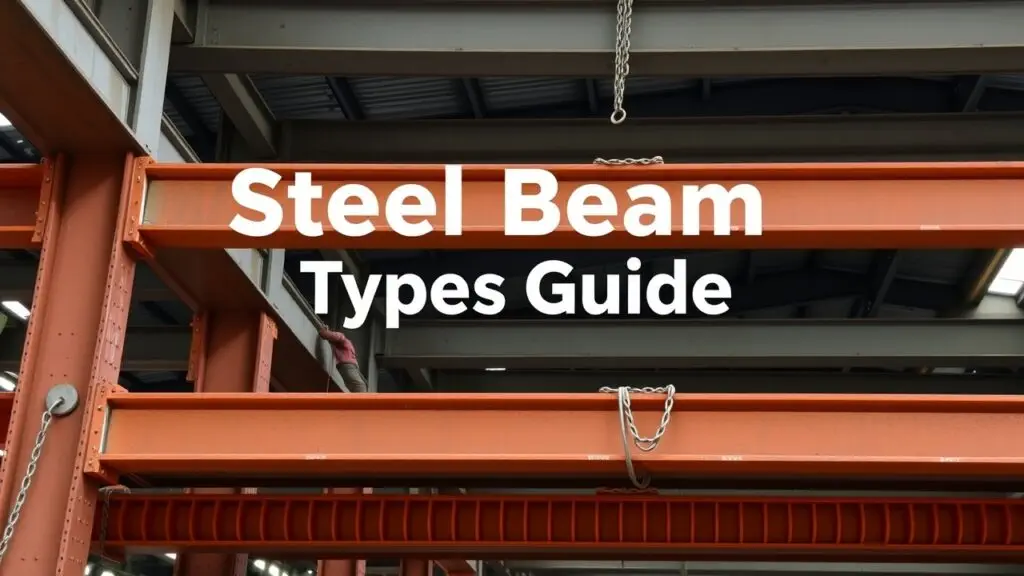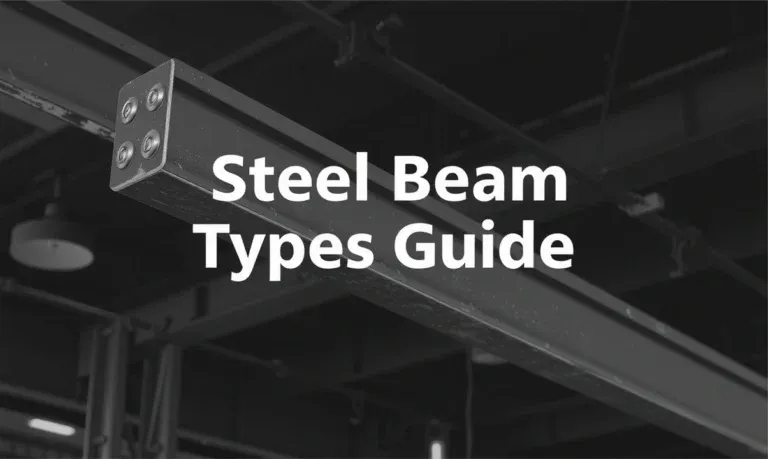This guide explains types of structural steel beams, including I-beams, channels, and angles, detailing their uses and applications in construction. Learn to select the right beam for your project.
What Are Structural Steel Beams?

Structural steel beams are key parts of buildings. They support and stabilize various structures. Made from strong steel, these beams can hold a lot of weight while keeping everything safe. Their main job is to carry loads from the roof or floors down to the ground. This helps buildings resist forces like gravity, wind, and earthquakes.
These beams are really important for load-bearing capacity and overall safety in building construction. If steel beams are not designed or placed right, buildings could fail under pressure. In civil engineering and architectural engineering projects, picking the right beam type is necessary for making sure structures work well and last long.
Why Understanding Different Types Matters?
Knowing the different types of structural steel beams is important for several reasons. First, it affects safety; using the wrong beam can cause serious accidents or structural failures. Second, understanding beam types helps with cost estimation in project management since materials can have different costs.
Also, knowing how each type works in certain situations helps builders follow safety rules during the project. This guide will explain several common types of structural steel beams: I-beams (or wide flange), H-beams, channel sections, angle sections, T-beams, and hollow sections.
| Type | Description |
|---|---|
| I-Beam/Wide Flange | Has an “I” shape; great for resisting bending |
| H-Beam | Looks like I-beams but has wider flanges; good for heavy loads |
| Channel Section | U-shaped cross-section; often used in frames or as supports |
| Angle Section | L-shaped cross-section; flexible for bracing |
| T-Beam | T-shaped section perfect for floors |
| Hollow Sections | Tubular shapes that offer a strong-to-weight advantage |
Understanding these types of structural steel beams can help construction workers make better decisions. It improves project efficiency while following industry standards.
I-Beams vs Wide-Flange Beams Explained
Structural steel beams are key parts of buildings and bridges. They help support weight and keep things stable. Two common types are I-beams and wide-flange beams. Knowing the differences between them is super helpful for builders, engineers, and architects.
What Is an I-Beam?
An I-beam looks like the letter “I” when you cut it across. This shape is great for carrying heavy loads without being too heavy itself. I-beams have special codes like W12x14. Here, “W” means it’s a wide flange, 12 tells you how deep it is in inches, and 14 shows its weight per foot in pounds. These beams meet ASTM standards that explain what materials should be used.
Advantages & Disadvantages of I-Beams
Advantages:
- High Strength-to-Weight Ratio: They can hold a lot of weight without being heavy.
- Ideal for Vertical Loads: Their shape makes them good at holding up things that push down on them.
Disadvantages:
- Susceptible to Buckling: They might bend if pushed sideways too hard.
- Limited Torsional Resistance: They don’t twist very well under certain forces.
Knowing how much an I-beam weighs and how much weight it can carry is important when picking materials for building projects.
Applications of I-Beams
I-beams are used a lot in construction because they’re strong and light. Here are some common uses:
- Building Frameworks: You’ll find them in houses and businesses as main supports.
- Bridges: Their strength makes them perfect for bridges that carry heavy traffic.
- Industrial Structures: Factories often use I-beams since they provide solid support over long distances without needing lots of extra material.
Wide-Flange Beam Characteristics & Applications
Wide-Flange Beam Features
Wide-flange beams, also called W-beams, have flanges that are wider than those on standard I-beams. This means they can hold more weight and are more stable. The wider flanges help spread out loads over a larger area. This is super important in heavy-duty projects where strength is key. People often use these beams in big structures like bridges and industrial buildings.
The design of wide-flange beams allows for good load distribution across longer spans. They are versatile and can fit into many construction projects.
How Do Wide-Flange Beams Differ From Standard I-Beams?
| Feature | Wide-Flange Beams (W-Beams) | Standard I-Beams |
|---|---|---|
| Flange Width | Wider flanges | Narrower flanges |
| Load Capacity | Higher | Lower |
| Stability | Greater | Less stable |
| Common Uses | Bridges, industrial structures | Residential buildings |
Wide-flange beams differ from standard I-beams in how they are built and used. The wider flanges mean they can handle bigger loads better than traditional I-beams. That’s why engineers prefer them for projects where strength and stability matter a lot.
Common Uses
You’ll find wide-flange beams in many heavy-duty projects. They are great for large-span bridges and industrial buildings that need to carry heavy weights. Here’s a quick list of common uses:
- Industrial structures
- Bridge construction
- Construction projects that need strong support systems
These features make wide-flange beams very important in modern steel construction practices.
Exploring Other Types of Structural Steel Beams
Structural steel beams come in many shapes and sizes. Each one is made for specific uses. Knowing about these types helps architects, engineers, and construction workers pick the right beam for a job.
Channel Sections (C-Shapes)
Channel sections are often called C-sections or channel beams. They have a “C” shape, which makes them strong but lightweight. These beams are great for many tasks. They are often used as purlins in roofing systems. They also support lightweight framing solutions in small houses. The open design makes it easy to attach other parts while staying strong.
Angle Sections (L-Shapes)
Angle sections look like the letter “L”. You can find equal angles and unequal angles based on how they are shaped. Equal angles have two legs that are the same length, while unequal angles have legs of different lengths. These sections are often used for bracing to connect other beam parts against shearing forces during building projects.
H-Beams
H-beams have a unique design that makes them ideal for heavy-duty jobs. Their wide flanges provide better stability under loads than I-beams do because I-beams have narrower flanges. This feature makes H-beams a smart choice when strength matters most.
These beams are common in large commercial buildings and bridges that need to hold a lot of weight safely.
T-Beams
T-beams look like the letter “T.” They consist of a vertical stem with horizontal flanges on top. They work well as composite beams in concrete structures since they can handle bending moments well. T-beams are key players in floor systems, helping spread out loads evenly across spans.
Hollow Structural Sections (HSS)
Hollow structural sections have some cool advantages over regular solid beams because they’re shaped like tubes. They offer high strength without much weight thanks to their unique shape. HSS is often used as columns in buildings or other tubular structures, ensuring they stay tough while taking up less space.
Overall, knowing about these different types of structural steel beams—channel sections, angle sections, H-beams, T-beams, and hollow structural sections—helps you make smart choices when picking materials for construction projects.
Comparative Analysis of Steel Beam Types
When building something strong, it’s key to know about different types of structural steel beams. Each beam has its own traits that make it great for specific jobs. Here’s a simple look at various beam shapes and their features.
Detailed Characteristics of Each Type
I-Beams
I-beams are super popular in construction. They have codes like W12x14. The “W” means wide flange, “12” is how deep it is in inches, and “14” is the weight per foot. These beams are good at holding up heavy loads while not bending too much because of their smart shape.
H-Beams
H-beams are stronger than regular I-beams. They work well when there are heavy loads. Their wider edges give them extra stability, making them great for factories or places that need to hold a lot without bending.
Channel Sections
Channel sections, or C-shapes, are lighter. They help with small support jobs like roof purlins or brackets. Their open shape makes it easy to attach them to other materials while still being strong enough to handle some weight.
Angle Sections
Angle sections, also called L-sections, come in equal or unequal sizes. They are mainly used for bracing inside structures. This helps resist forces that might push the building sideways.
T-Beams
T-beams mix steel and concrete together to make strong floors. They help spread weight across large areas. This is useful for buildings with many stories where floors need to be solid but not heavy.
Hollow Structural Sections (HSS)
Hollow Structural Sections are tubular shapes that have a good strength-to-weight ratio. They are great for columns or other support structures because they can handle both straight down forces and side forces well while looking nice too.
Knowing these types of structural steel beams helps builders choose the right materials for their projects. This makes sure everything stays safe and strong over time.
Steel Beam Selection Criteria and Best Practices
Choosing the right steel beam is super important for construction projects. This choice affects how strong, safe, and cost-effective the building will be. Knowing what to look for can help people make better choices.
Factors Affecting Steel Beam Selection
There are many things to think about when picking a steel beam:
- Load Capacity: Different types of steel beams can carry different amounts of weight. It’s key to know how much weight the beam needs to support, both from people and stuff in the building.
- Span Length: This means how far apart the supports are. If the distance is long, you might need a stronger beam or a different kind to keep it from bending too much.
- Deflection Limits: Building codes tell us how much a beam can bend under weight. Engineers must choose beams that won’t bend too much, so everything stays safe and looks good.
- Cost Considerations: Money matters! Some beams might work better but cost more. Finding a good balance between performance and price is important.
- Aesthetic Requirements: Sometimes, how a beam looks matters just as much as how it works. The right beam should fit with the overall design while still being strong.
- Compliance with Building Codes: Following local building rules is a must. These codes set standards for safety and performance that all beams have to meet.
Knowing these factors helps make better decisions when selecting steel beams, leading to safer and more efficient designs.
Using Engineering Specifications and Design Software
Using engineering specs with design software makes choosing beams easier. Tools for structural engineering help create models based on different weights, lengths, and materials.
These programs do lots of math to show how weight will spread out and affect each type of steel beam like I-beams or H-beams. By simulating real-life conditions on the computer first, we can find problems early. This saves time and money when building starts.
Role of Structural Engineers in Beam Selection
Talking with structural engineers is very important when picking a beam. They know a lot about how buildings work and what makes them safe. Engineers check every project’s needs, looking at things like weather or special designs that could change what beams work best.
Best Practices
To keep steel beams working well for a long time:
- Handle beams carefully during transport to avoid damage; use protective coverings if needed.
- Cut beams precisely so there are no mistakes that could cause issues later.
- Follow strict welding practices to keep connections strong.
- Use solid bolting methods to make sure everything stays tight over time.
Safety should always be at the front of our minds from planning all the way through installation. Regular checks help ensure that steel structures last long and stay safe for everyone involved.
Advanced Topics in Steel Beam Design and Application
Steel Beam Connections
Connecting steel beams is super important for keeping buildings strong. There are three main ways to connect steel beams: bolting, welding, and riveting.
Bolting uses strong bolts to hold the beams together. It’s easy to put together and take apart, which is great for structures that might need changes later. Bolted connections can also move a little, which helps with heat or earthquakes.
Welding is a process where the edges of the steel are melted and fused together. This usually makes a stronger connection than bolting, but it needs skilled workers to do it right. If not done carefully, welds can crack or not hold properly.
Riveting is an older method but still worth mentioning. You heat rivets until they’re soft and then hammer them through holes in the beams. While it creates strong joints, it’s mostly been replaced by bolting and welding because those methods are quicker.
Choosing how to connect steel beams really matters for how strong the structure will be. For example, welded connections can handle more weight than bolted ones, but they need more checks during construction to make sure they’re done right.
Steel Beam Manufacturing Processes
Knowing how steel beams are made is key when picking the right kind for a project. There are two main processes: hot-rolled and cold-formed.
Hot-rolled steel is made by heating it up before shaping it, which makes it easier to form into shapes without internal stresses after cooling down.
Cold-formed steel involves bending metal sheets at room temperature. This method can keep higher internal stress levels in the final product, which might affect how long it lasts under heavy loads.
When deciding between hot-rolled or cold-formed steel, think about what kind of conditions the beam will face after installation. This choice helps make sure the beam will last long while meeting all safety standards set by groups like AISC or ASTM.
Additional Considerations
Today, sustainability is key in engineering practices. Using recycled materials from old structures can help cut down on waste and energy use during production.
There’s a push toward better energy efficiency in making new beams too. Modern methods aim to lower waste during production and help create eco-friendly buildings that benefit everyone over time!
Frequently Asked Questions (FAQs)
What are the different types of structural steel beams?
Structural steel beams come in several types, including I-beams, H-beams, channel beams, angle sections, and hollow sections. Each type has unique strengths and uses in construction.
How do I choose the right steel beam for my project?
Select a steel beam based on load capacity, span length, and deflection limits. Consider costs and aesthetic needs. Consulting with a structural engineer can provide valuable insights.
What are RSJs and their uses in construction?
RSJs, or Rolled Steel Joists, are I-shaped beams often used for support in buildings. They provide strength and stability for floors and ceilings.
What is the difference between equal angles and unequal angles?
Equal angles have two legs of the same length. Unequal angles have legs of different lengths. Both types are used for bracing and support in various structures.
What are taper flange beams?
Taper flange beams have flanges that narrow towards the ends. They offer good strength-to-weight ratios and are useful in lightweight structures.
How do wide-flange beams differ from channel sections?
Wide-flange beams have wider flanges compared to channel sections. This design allows them to handle greater bending moments effectively.
What are the benefits of using hot-rolled steel for beams?
Hot-rolled steel provides better shaping capabilities and reduces internal stresses during production. This makes it ideal for high-strength applications.
How do I find the right size for my steel beams?
Use a sizing chart like the UB sizing chart to determine dimensions based on load requirements and span lengths.
Types of Steel Beams
- Explore universal columns (UB), C-sections, H-sections, L-sections, rectangular hollow sections, square hollow sections, and circular hollow sections.
- Utilize pre-cambered beams for better load distribution.
Construction Applications
- Use floor bearer beams in residential construction.
- Apply lintel beams above doorways to support wall loads.
- Select strutting beams to reinforce structures against lateral loads.
Steel Beam Maintenance
- Regularly inspect steel beams for corrosion.
- Implement non-destructive testing to ensure safety over time.
Related Topics
- Types of steel beams
- Types of steel beam connections
- Types of steel beam manufacturing processes
- Types of angles (equal and unequal)
- Types of steel beam applications
- Types of steel beam specifications
- Types of structural analysis for steel beams



Types of Structural Steel Beams: A Complete Guide to Steel Sections & Applications